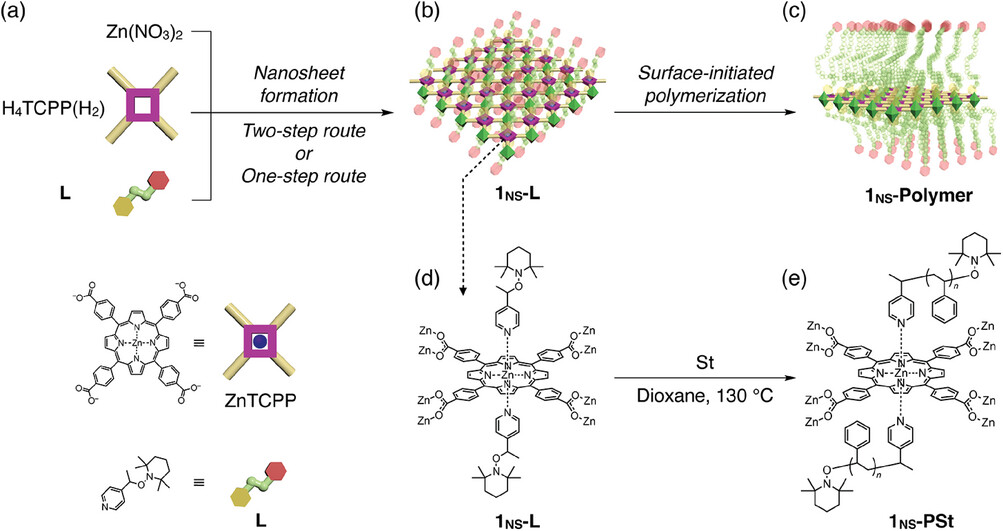| Dec 05, 2023 |
|
|
|
(Nanowerk Spotlight) Researchers are exploring two-dimensional (2D) metal-organic frameworks (MOFs) – crystalline materials with incredibly thin, nanoscale thickness – for advanced applications in separation, catalysis, electronics and energy storage. But a major roadblock has endured. The innate material instability leaves these delicate structures aggregated and unusable.
|
|
Now, scientists at the University of Tokyo have overcome this barrier with a novel polymer grafting technique to finally harness the long-awaited promise of 2D MOFs. They report their findings in Advanced Functional Materials (“Polymer-Grafting from MOF Nanosheets for the Fabrication of Versatile 2D Materials”).
|
 |
| Overview of the synthesis of polymer-grafted MOF nanosheets. a) Synthesis of dispersed MOF nanosheets functionalized with polymerization initiating agent (L) on the surfaces (1NS–L), which is achieved by both two-step and one-step routes. H4TCPP(H2) denotes protonated version of TCPP in a free base form. b) Subsequent surface-initiated polymerization from 1NS–L provides c) polymer-grafted MOF nanosheet (1NS–LPolymer). Chemical structure of the ZnTCPP unit in d) 1NS–L and e) polystyrene (PSt)-grafted MOF nanosheet (1NS–LPSt). (© Advanced Functional Materials)
|
|
Historically, the allure of 2D MOFs has been their unique combination of high structural versatility and ultra-thin planar morphology. This grants both incredible processability for industrial uses and also intricate control to tune the internal molecular transport pathways. However, past attempts to develop 2D MOF membranes for water purification or catalysts beds for clean energy production run into the same issue – the materials are too unstable in real-world operating environments.
|
|
The crucial challenge lies in the intrinsically high surface energy of 2D sheets, causing them to stack up into useless aggregates unless extremely high dispersant loads are used. But here the new polymer grafting concept provides a watershed moment. By decorating the MOF sheets with precisely anchored polymer chains, the researchers demonstrate full control over surface chemistry, structure and properties. No longer left to aggregate, the polymer-wrapped sheets maintain processability for constructing functional membranes and devices.
|
|
The study centers on grafting vinyl polymers – chains of repeating organic molecules – to nanosheets of ZnTCPP, a prototypical 2D metal-organic framework material comprising zinc atoms coordinated by organic linker molecules. But application of this concept promises to unlock the whole field of 2D MOF research previously hampered by poor stability.
|
|
The researchers incorporated specially designed “initiator” molecules into the ZnTCPP framework that allowed polymer chains to grow straight out from the nanosheet surfaces while leaving the internal crystalline structure intact. Adding styrene or fluorinated styrene monomers enabled growth of customizable polymer brushes out from the entire planar surfaces. Detailed analyses confirmed polymers with programmed length and composition were covalently tethered to the sheets by robust chemical anchoring sites.
|
|
So rather than aggregating into stacked piles, the 2D ZnTCPP crystals now exhibit free-floating individual nanosheets coated with stabilizing polymer layers. This nano-hybrid material merges the advantages of facile polymer processability and precise control over MOF pore structure pathways.
|
Demonstrating the potential of their approach, the team first grafted normal polystyrene chains to make organophilic ZnTCPP hybrid sheets. Dispersed effortlessly in solvents, their installed Zn-porphyrin active sites catalyzed chemical reactions under light irradiation – something impossible without polymer aid.
Next, grafting perfluorinated polystyrene chains created new superhydrophobic properties. Nanosheets floated perfectly on water without wetting. Stacked into a membrane, this allowed efficient filtering of emulsified oil/water mixtures 20 times over with zero loss of performance – a breakthrough for sustainable water purification.
|
|
The study provides a platform to construct 2D polymer-MOF hybrids with almost limitless tunable facets by selecting different polymers and MOFs. Patterned nanosheet films for selective gas separation and sensing could aid environmental protection and healthcare. Incorporating electrically conductive MOFs promises polymer-wrapped nanosheet anodes for smaller and safer lithium batteries in electric vehicles. Specifically functionalizing biological membranes also moves into sight for orchestrated drug transport and biosensing.
|
|
Commercial upscaling looks in easier reach without aggregation worries. After years stuck in the laboratory, unlocking stability and processability brings 2D metal-organic frameworks tantalizingly close to transforming sustainable large-scale technologies.
|
|

By
Michael
Berger
– Michael is author of three books by the Royal Society of Chemistry:
Nano-Society: Pushing the Boundaries of Technology,
Nanotechnology: The Future is Tiny, and
Nanoengineering: The Skills and Tools Making Technology Invisible
Copyright ©
Nanowerk LLC
|
|
|
- SEO Powered Content & PR Distribution. Get Amplified Today.
- PlatoData.Network Vertical Generative Ai. Empower Yourself. Access Here.
- PlatoAiStream. Web3 Intelligence. Knowledge Amplified. Access Here.
- PlatoESG. Carbon, CleanTech, Energy, Environment, Solar, Waste Management. Access Here.
- PlatoHealth. Biotech and Clinical Trials Intelligence. Access Here.
- Source: https://www.nanowerk.com/spotlight/spotid=64185.php





